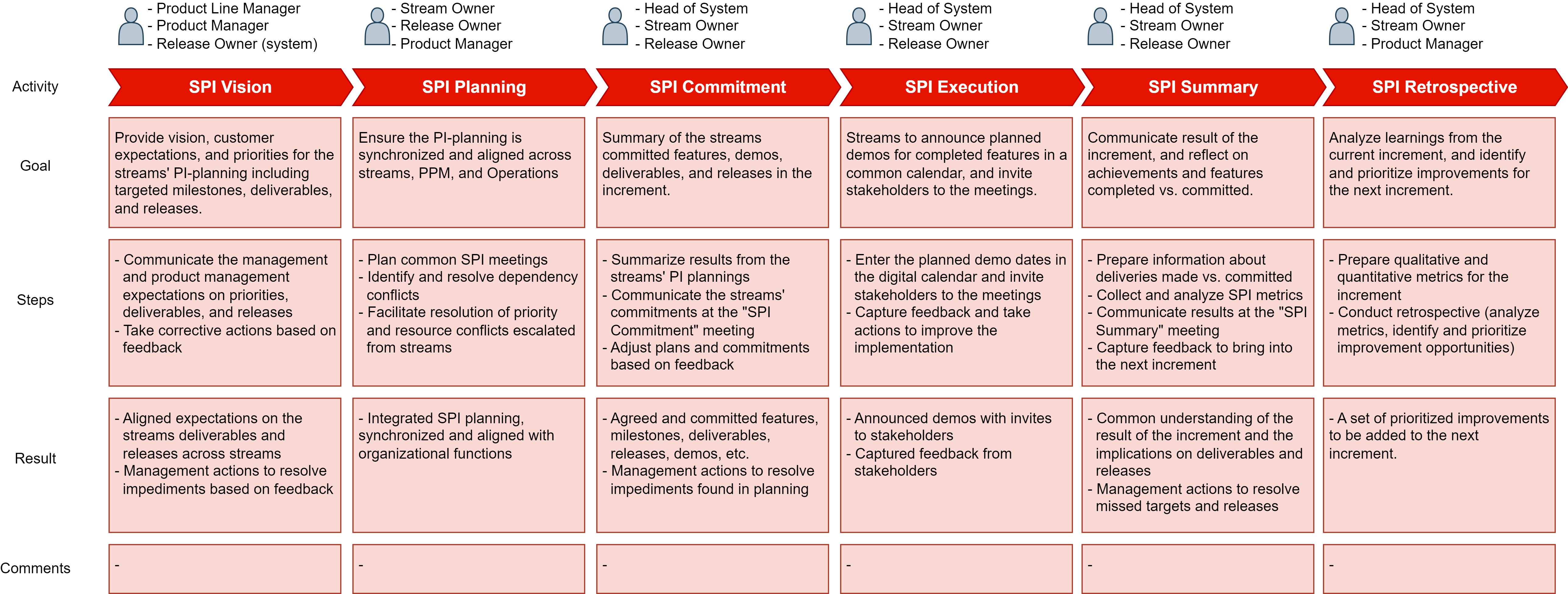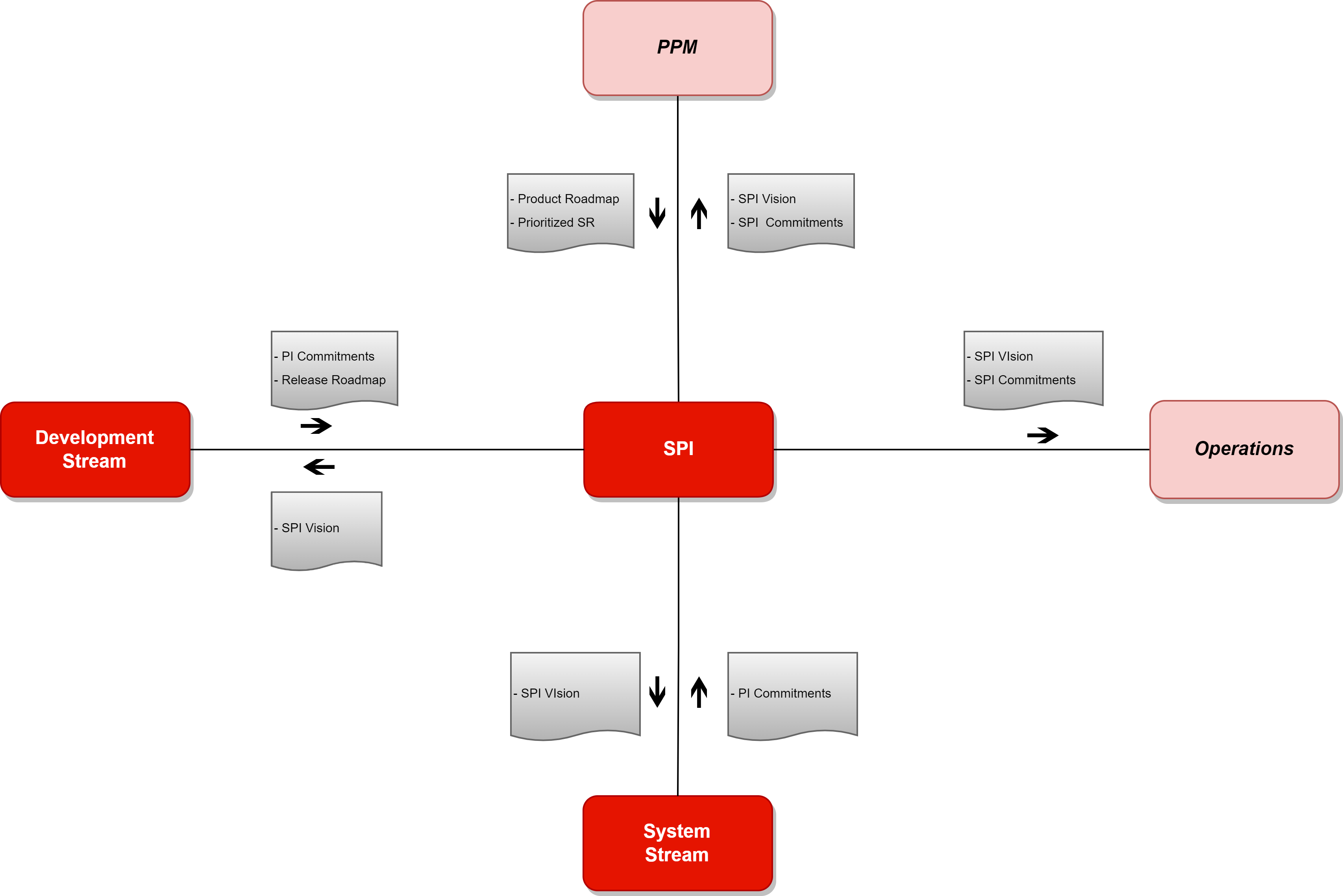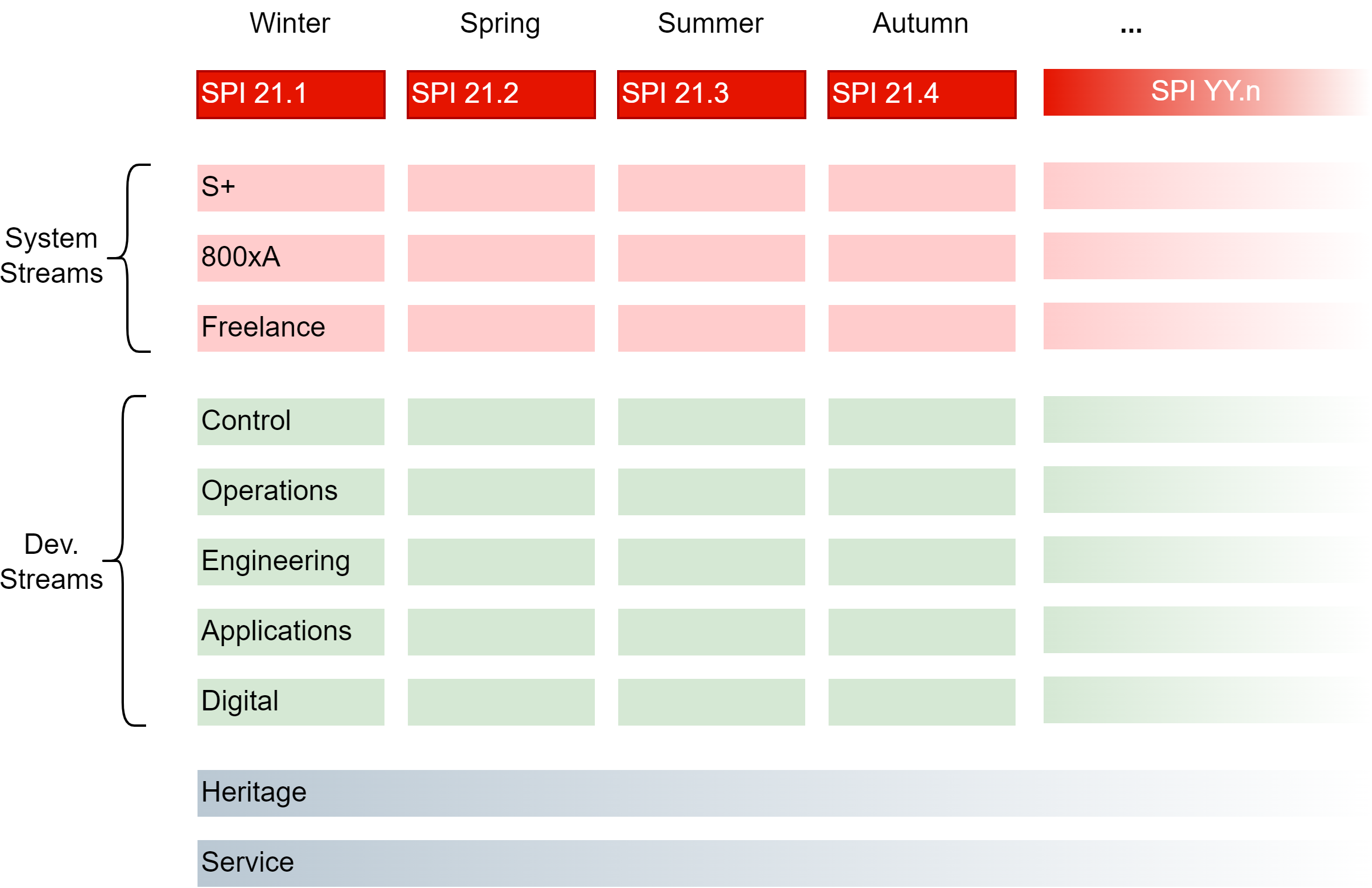SPI Coordination
The Synchronized Program Increment (SPI) sets a common cadence, synchronizes, and aligns the PCP organization (e.g. PPM, R&D, and Operations) towards common PCP business goals. The SPI also creates openness and transparency across organizational functions by inviting key stakeholders to synchronization meetings where issues, conflicting expectations, and dependencies are highlighted before they get critical.
The SPI sync meetings (vision, commitment, summary, and retrospective) also facilitate decisions to resolve impediments. The intention of the sync meetings is also to increase predictability, improve learning, and encourage continuous improvements. Quality issues can be detected early in SPI demos, where the streams and teams show integrated, tested, and working solutions (software and hardware).
PCP Management (e.g., head of PPM, head of R&D, head of Operations) communicates the overall priorities and resolves any organizational impediments. PPM presents the business goals and customer expectations, and R&D responds with plans, demos, deliverables, and releases.
The SPI engages all streams, teams, and organizational functions in PCP. The SPI cadence triggers the system- and development streams to do their PI planning and execution.
Process Overview
The SPI planning and execution follow the lean- and agile values and principles (see Lean-Agile Execution for details).
Principles
- Synchronize and align the PCP organizational functions toward common business goals
- Promote openness and information sharing across the organizational functions (celebrate success and learn from failures)
- Ensure the participation of key stakeholders to remove impediments, mitigate risks and facilitate decision-making
- Provide a clear purpose and expectations for the required SPI meetings
- Provide a rolling calendar with increments and fixed dates for SPI meetings
- Facilitate resolution of strategic issues across streams (dependencies, deliverables, releases, resources)
- Make sure there is a realistic balance between expectations, release targets, and available capacity
Activities

Artifacts
| Artifact | Description | Receiver | Comments | |
|---|---|---|---|---|
| SPI Vision. | A presentation of the SPI objectives to be achieved in the increment. Shows prioritized System Requirements prepared by PPM. | (R): Product Manager (A): Product Line Manager (C): - (I): - | Streams & Teams | - |
| SPI Commitment. | A presentation of the result from the PI planning by the streams - highlighting releases, dependencies, issues, and risks. The streams commit to features and deliverables based on DevOps backlogs. | (R): Stream Owner (A): Head of System, Head of Development (C): - (I): - | Streams & Teams | - |
| SPI Demo Calendar. | A calendar where streams define their planned demos, available to all stakeholders. | (R): Stream Owner (system) (A): Head of System (C): - (I): - | Streams & Teams | - |
| SPI Summary. | A presentation of the result accomplished during the increment for all streams based on DevOps backlogs. | (R): Stream Owner (system) (A): Head of System (C): - (I): - | Streams & Teams | - |
| SPI Retrospective Item List. | The result of the SPI retrospective meeting with prioritized improvements for the next increment to be added into the stream backlogs. | (R): Stream Owner (system) (A): Head of System (C): - (I): - | Streams & Teams | - |
Dependencies

Details
SPI Cadence
The recurring SPI meetings highlight issues early (e.g., prioritization issues, capacity issues, dependencies, and delays). The start and end of the increments become natural points in time to (re-)align the streams and related organizational functions to the PCP business goals.

Servant leadership encourages the streams to be transparent - celebrate the accomplishments and inform about failures. The managers support the streams and teams to recover from failures and use their knowledge and skills to lead the streams to success.

An SPI calendar shows all the increments and meetings over the year. The meeting times are fixed and communicated to participants in advance, i.e., everyone knows when the meetings occur and can plan and prepare the information well in time.
Use the SPI meetings to identify issues. Don't discuss and try to solve the issues at the meeting! Capture the issues and decide the responsible persons to invite to separate meetings and find solutions.
SPI Coordination Team
The SPI Coordination team (agile PMO) measures value meaningful to stakeholders and customers, not auditors and accountants.
A small management team organizes and invites stakeholders to the SPI meetings. The team serves and moderately governs the lean-agile execution. The team applies servant leadership to support the streams to define the vision, set the boundaries, remove impediments, and mitigate risks. The SPI team empowers the streams to self-organize within the agreed boundaries.
The team sets up the basic infrastructure and tools to share information across the organization about the increments. A yearly rolling calendar provides information about dates for the increments and demos.
The team focuses on PCP R&D but extends to other organizational functions as well. They invite the key stakeholders from management to ensure decisions can be taken directly at the meetings.
SPI Cadence and Naming
The SPI cadence (intervals) is about 13 weeks and approximately follows the yearly quarters. A common SPI calendar shows all the increments and meetings over the year.

The names of the SPIs are defined as follows:
SPI <YY>.<n>
<YY> - last 2 digits of the year ("20", "21", "22")
<n> - [1..4] (sequence number of the quarter)
Example: "SPI 21.1", "SPI 21.2", ...
Extend the SPI name with the event to get the entry for the calendar:
SPI <YY>.<n> - <event-name>
<event-name> - "Vision", "Commitment", "Summary", "Retrospective"
Example: "SPI 21.1 Vision", "SPI 21.2 Commitment"
SPI Vision
SPI Vision meeting takes place on the first day of the SPI.
The SPI Vision is a meeting to provide a vision and input to the streams' PI planning. Product Portfolio Management (PPM) provides an inspiring portfolio vision for the increment with customer targets and priorities. All requirements are channeled through PPM to give a consistent view of the targets and priorities to R&D.
R&D management provides their goals and expectations. The release owners provide more hands-on expectations in terms of milestones, deliverables, and releases.
Participants of the meeting (all functions are from PCP):
- R&D head (presenter)
- PPM head (presenter)
- Operation head
- PMO head
- R&D stream owners
- PLM team (presenter)
- Platform PM team (presenter)
- Service PM team (presenter)
- Digital PM team (presenter)
- Segment PM team
- R&D system leads
- R&D architecture team
- R&D system release owners (presenter)
- R&D product release owners
- R&D Product owners (product & system)
- R&D cyber-security responsible (product & system)
- R&D scrum masters
- R&D OpEx team
- R&D STT team
- L3 responsible (of products across PCP, suggestion as per L3 head of PCP)
SPI Commitment
SPI Commitment meeting occurs during the first PI-sprint once all the stream PI's are concluded and have clarity on their commitments.
The SPI Commitment is when the PI planning and commitments of each stream are summarized. During the meeting, the individual development streams present their commitments. The system streams present a consolidated view of commitments.
Participants of the meeting (all functions are from PCP):
- R&D head
- PPM head
- Operation head
- PMO head
- R&D stream owners (presenter)
- PLM team
- Platform PM team
- Service PM team
- Digital PM team
- Segment PM team
- R&D system leads
- R&D architecture team
- R&D system release owners (presenter)
- R&D product release owners (presenter)
- R&D Product owners (product & system)
- R&D cyber-security responsible (product & system)
- R&D scrum masters
- R&D OpEx team (presenter)
- R&D STT team (presenter)
- L3 responsible (of products across PCP, suggestion as per L3 head of PCP)
SPI Summary
SPI Summary meeting occurs at the end of the increment when the streams present the consolidated result.
The SPI summary is about wrapping up the SPI results and reflecting upon the achievements/deliverables made vs. committed in the SPI Commitment meeting at the beginning of the increment. Perform an analysis of the KPIs, including corrective actions, as a part of the summary.
Participants of the meeting (all functions are from PCP):
- R&D head
- PPM head
- Operation head
- PMO head
- R&D stream owners (presenter)
- PLM team
- Platform PM team
- Service PM team
- Digital PM team
- Segment PM team
- R&D system leads
- R&D architecture team
- R&D system release owners (presenter)
- R&D product release owners (presenter)
- R&D Product owners (product & system)
- R&D cyber-security responsible (product & system)
- R&D scrum masters
- R&D OpEx team (presenter)
- R&D STT team (presenter)
- L3 responsible (of products across PCP, suggestion as per L3 head of PCP)
SPI Demo
SPI demos occur during the execution of the SPI
At the SPI Demo, the integrated new features are demonstrated to stakeholders to share progress and receive feedback. Both system- and development streams can provide demos. The planned demos are visible in a common calendar and are open for anyone to join.
Participants of the meeting (all functions are from PCP):
- PLM team
- Platform PM team
- Service PM team
- Digital PM team
- Segment PM team
- R&D system leads
- R&D architecture team
- R&D system release owners
- R&D product release owners
- R&D Product owners (product & system) (presenter)
- R&D cyber-security responsible (product & system)
- R&D scrum masters
- R&D OpEx team
- R&D STT team
SPI Retrospective
SPI Retrospective occurs after the SPI
The SPI retrospective is an opportunity to evaluate learnings from the past increment and identify improvements for the future. The result from the SPI Summary is an input to the retrospective since it summarizes the actual deliverables and results.
The retrospective is also an opportunity to share best practices along the streams - what has worked well in teams within one stream can likely provide good results in other streams. Similarly, negative learnings can be shared to help others avoid stepping on the same slippery stones. There can be several retrospectives taking place during the SPI to reflect on specific parts of the SPI.
Selected improvements from team and stream retrospectives can be brought to the SPI Retrospective if it involves several streams or affects the whole organization. The "heads" of the organizational functions participate in the SPI Retrospective and decide on improvement actions.
Participants of the meeting (all functions are from PCP):
- R&D head
- PPM head
- R&D stream owners (presenter)
- PLM lead
- Platform PM lead
- R&D system leads